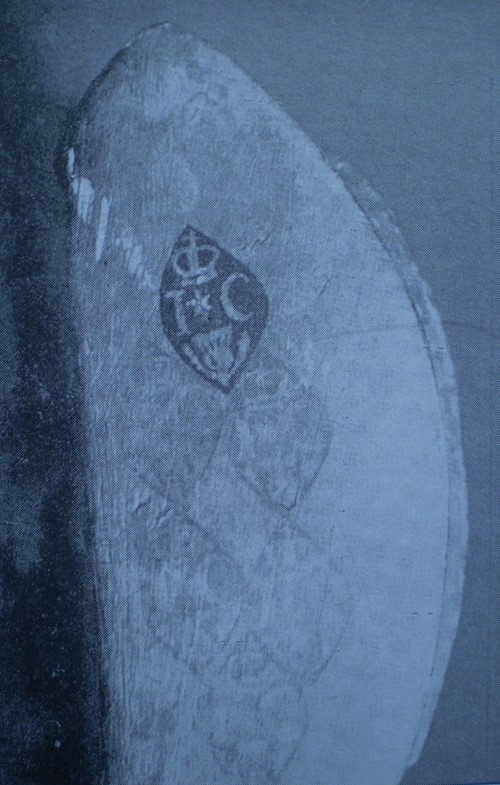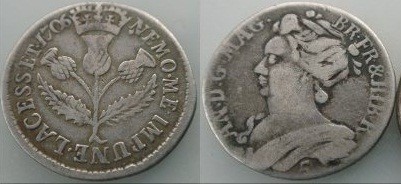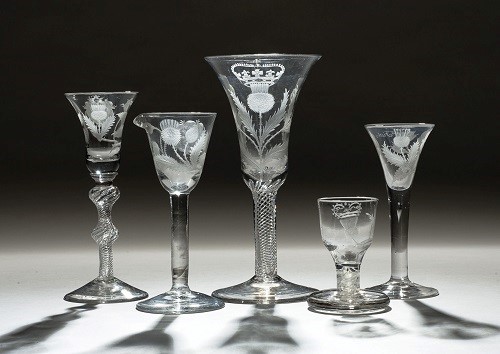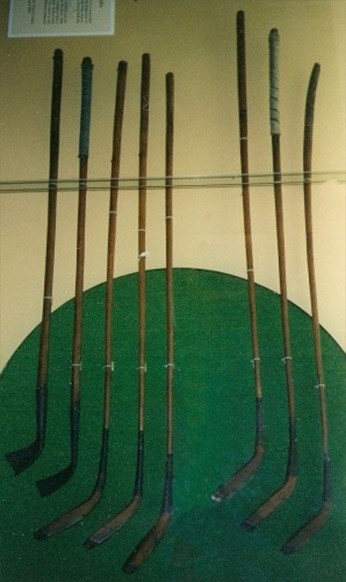Article Written in 2011
- The Troon Clubs & Jacobites
A Theory on the Provenance of The Troon Golf Clubs
Having been fascinated for some years with the Troon Clubs I have read with great interest the recent views and theories of Bob Gowland, Jeff Ellis and Ian Crowe on the provenance of these ancient clubs. In his recent book, The Oldest Clubs, Bob concludes that they approximately date to the 1740s evidenced by their similarity to the silver prize clubs of the golfing societies of Leith,St Andrewsand Blackheath. Ian concluded in the June 2010 edition of Through The Green that the symbols stamped on them indicate the clubs belonged to James I ofEngland(VI of Scotland) and were made for him around 1603 by William Mayne. In the September 2011 edition of Through the Green Jeff openly backs Ian's theory and adds weight to it by suggesting that the silver prize club of the R&A was purposely made in 1754 to resemble clubs made for a Stuart king around 150 years earlier, because the society wished to 'openly celebrate their antiquity of the game and rekindle its connection to royalty'. I wish to offer my own thoughts and conclusions regarding their age and the significance of their very distinct markings.One of the Troon Clubs

It is accepted that the Troon Clubs are extremely similar in shape and form to that of the silver prize clubs made in 1744, 1754 and 1766. Jeff's theory that in 1754 the Society of St Andrews Golfers purposely commissioned a copy of an already antique club made for a Stuart king might hold more credence if this was an isolated example. However, I think it highly improbable that all three golfing societies would think the same, and follow suit in this notion, particularly considering what I shall explain below. The fact that the new captains of each society attached a silver ball to these silver clubs, and that it is reported that these balls are actual featheries covered in silver in the case of the Blackheath club, reinforces Bob's conclusions that that the prizes clubs were copies of contemporary equipment in use at the time. The documents extant that refer to the commissioning and competition for the silver clubs do not refer at all to them being of an antique form, and certainly not connected in any way to the Royal House of Stuart.
The rediscovery of the Troon Clubs
The report of their discovery in the August 15th 1898 edition of The Times newspaper, as re-printed in the book by Hutchinson, makes a number of 'factual' statements which can now be proved wrong, cannot be substantiated, and, I believe, are potentially misleading.1 The report states that Maister House in Hull, in which they were found, 'burned down in the year 1700'. This is incorrect. The house fire, in which four lives were lost, took place on the night of the 12th and 13th of April 1743. There are conflicting reports as to the severity of damage caused by the fire, but as the Business Day Book survives to this day it is logical to assume that not all of the contents of the house were totally destroyed. What is clear, however, is that the house was totally rebuilt after the fire by local architect and builder Joseph Page in the New Palladium style, with Lord Burlington advising on the plans.2 Re-building began in 1743 and was 'well underway' by the winter of 1744.2 The Times report states that a quantity of old documents, including a Yorkshire newspaper dating 1741, was found with the clubs. I believe all this can ever indicate is the general timeframe in which that particular cupboard was in use before it was sealed up, presumably done so on purpose to keep the contents secure. The newspaper may have contained some information the Maister Family wished to retain, or keep secret, or indeed it might just have been any old three year-old newspaper used to line the cupboard in the newly constructed house. Another possibility is that The Times wrongly reported the date of the early newspaper. Anybody who has had dealings with newspapers at any time in their lives will know that they very often get the details wrong (evidenced by the date given for the house fire).
The Times report states that the leading politician, Arthur Balfour, a very keen golfer, had given his opinion that the clubs belonged to the period of the Stuart kings. Furthermore, that the symbols on the clubs, a thistle, a crown, and the letters I (likely to be a J) and C, 'do represent the name of the maker' or 'denote a special permission on the part of one or other of the kings of Scotland' (boldings are my own). I believe that these statements, whilst on the right track, have channelled thinking towards an early seventeenth century date of manufacture ever since. This is demonstrated by the 1993 reappraisal of the clubs by the Johnstons, who rightly pointed out that whilst 'no monarch since James II (of England) was deposed in 1688 has shown any propensity for golf', they incorrectly tied the use of the crown with the thistle to suggest that the Troon clubs could even date to before 1603 because that's when the Scottish crown ceased to be an independent preserve.4 In his recent article Ian Crowe states 'the Crown represents royalty and would only have been used by royalty or with their consent'. When he combines this with the use of a Stuart Thistle on an early James I coin this leads him to conclude an early seventeenth century date of manufacture. In fact, many coins up to 1706 carried this symbol (and still do today!). What is much more important, however, is that crowns, thistles and stars were used on many different types of objects to show support for the Kings of England and Scotland well into the mid-1700s; it's just that the kings in mind weren't actually occupying these thrones at the time.
The Significance of the Stamped Symbols
I believe that to fully understand the significance of the markings on the clubs we must consider the drastic changes in the monarchy ofEnglandandScotlandin the seventeenth and eighteenth centuries. In brief, the Scottish House of Stuart (or Stewart as it is sometimes written) united the two thrones in 1603. A key event occurred when King James II ofEngland(VII of Scotland) was deposed by parliament in 1688. Thereafter, his descendants, referred to as Jacobites, led a series of uprisings, rebellions and mini-wars, in an attempt to regain the throne. The major Jacobite rebellions took place in 1715 and 1745, being led by the Old Pretender, James Francis Edward Stuart, and the Young Pretender, Prince Charles Edward Louis John Casimir Sylvester Severino Maria Stuart, respectively. Charles is better known as Bonnie Prince Charlie. In the early decades of the eighteenth century, and even after their final bloody defeat at the Battle of Culloden in 1746, Jacobites were keen to display their true allegiances through the use of certain symbols. They had to be very secretive as being a Jacobite, or even associating with them, was a treasonable offence likely to incur the death penalty. In one of his books, David Stirk, explains at length this is why the early golfing societies, whose members were also connected through freemasonry, destroyed their records and why no golf society records, particularly any lists of members, exist from before 1744.5 A trawl of the internet reveals how Jacobites incorporated their loyalty symbols, sometimes overtly sometimes covertly, into the design of all manner of things including jewellery, paintings, weaponry and household items. Ornate crowns, thistles and stars were beautifully engraved on fine wine glasses. The star is cited as signifying the rise of a new hope in Bonnie Prince Charlie.6 These fragile glasses could obviously be destroyed at a moment's notice should the authorities come calling, and only a few have survived.
A Queen Anne Pre-Union five shillings piece dated 1706 with a Stuart Thistle. Reproduced by Permission.7

Jacobite Drinking Glasses
The far left one has a thistle below a star. The centre and centre-right ones have crowns above thistles. Reproduced by Permission.8

My new Jacobite Theory
My conclusions are these: the Troon Clubs were made sometime in the early to mid-1700s, perhaps even as early as 1720 when Bonnie Prince Charlie was born. This is evidenced by them being of near identical form to the three silver prize clubs known to have been made between 1744 and 1766 from three separate golfing societies. They are stamped with Jacobite symbols. The I/J stands for James (Iacobus/Jacobus in Latin) referring to either King James I of England (VI of Scotland), the deposed King James II of England (VII of Scotland), or the Old Pretender who took the liberty of crowning himself King James III of England (VIII of Scotland) whilst in exile. The C stands for Charles (Carolus in Latin), the Young Pretender a.k.a. Bonnie Prince Charlie. The crown and thistle demonstrates the Jacobite (House of Stuart) claim to the throne. Considering the hysteria, persecution and retribution occurring in Scotland and England against anyone remotely showing support for the Jacobite cause in the eighteenth century it would have been suicidal for anyone to even consider styling their new silver prize clubs in 1744, 1754 and 1766 after real clubs made for previous Jacobite monarchs, and then furthermore parading them through the streets.
How the Troon Clubs came to be in Maister House inHullrequires more investigation, however, it is interesting to note certain things about the Maister family and their business associates. The Maister families were very successful international trading merchants, soldiers and politicians and traded regularly and lived at various times on the continent.9 Henry Maister (1699 - 1744), the occupant of the old house at the time of the fire in 1743 was a Whig MP, a political party known to be very anti-Jacobite. After Henry died in 1744, his younger brother, Nathaniel Maister (1703 - 1772), oversaw the completion of the new house but reputedly never lived in it. Henry Maister, (1730 - 1812), lived in the new house from 1760 and was 'devoted to the militia and became Colonel of the Regiment (the East Yorkshire Regiment) in 1778'. Letters between Henry Maister and a Christopher Sykes (1749 - 1801), another Hull merchant, still exist which confirms they knew and trusted each other.10 Interestingly, Richard Sykes (1706 - 1761), who appears to be Christopher's father, was 'Captain of the Hull Volunteers, about the Jacobite rebellion of 1745'. Furthermore, and perhaps of no small coincidence, it was a Mr JC Sykes who owned Maister House in 1898 and who found the clubs in the concealed cupboard. It does not appear likely that any of the Maister or Sykes family were secret Jacobites; their activities seem distinctly anti-Jacobite. However, they were certainly men who would have come into contact with Jacobites, either amicably through international trade, or as a direct result of armed conflict.
I believe that the clubs were once the possession of a wealthy golfing Jacobite and may have been 'liberated' as battle booty around the time of the second rebellion of 1745 and came into the possession of either a Maister or a Sykes, those being military commanding officers. It is well documented that John Rattray, who drew up the first rules of golf in 1744, was a confirmed Jacobite and was the personal physician to Bonnie Prince Charlie in 1745. He only escaped execution after being captured at the Battle of Culloden in 1746 thanks to the intervention of his well-connected golfing chum Lord Duncan Forbes.11 There are several stories of the Bonnie Prince being a golfer and playing in the gardens of the Villa Borghese in Rome as a child and as an older man during his final exile; perhaps he even left his favourite set behind when he fled after Culloden? The Troon Clubs are in remarkably good condition, and I believe, they were placed in the cupboard in Maister House in the late 1740s or early 1750s after seeing comparatively little use. Given the Jacobite symbols the clubs would have been kept well out of view of any prying eyes, and maybe their new owner even viewed them as a sort of insurance policy should the Jacobites have risen in armed rebellion again and came calling. Fear of this possibility only subsided in the late 1760s; Stirk highlights 'it was not until 1770, 25 years after the second Jacobite uprising, that the Gentlemen who golfed at St Andrews finally allowed themselves to be referred to in a Minute as 'The Society of Golfers at St Andrews', as in the aftermath of Culloden any organised club, particularly of Scotsmen, would have been viewed with suspicion.12 Indeed, it was not until 1763 when the second edition of the poem The Goff was printed, that the author, Thomas Mathison (1721 - 1760) was posthumously identified and the players' names inserted. The first edition of 1743 just had lots of blank spaces in the text. In his 1955 book, Robert Browning states, 'presumably the "points" of the local cracks were so well known that Mathison could leave golfing readers to fill in the familiar surnames for themselves.'13 I think Browning missed the reason completely; the author published anonymously in 1743 and left out the names of Rattray, Forbes, Biggar, Alston, Brown, Dalrymple et al, because he perhaps knew that some of them had Jacobite sympathies, and there was fear they might all be implicated and accused of treason.
In summary, there is strong evidence to conclude that the Troon Clubs date from the early to mid-eighteenth century and are linked to the Jacobite cause. A large amount of Maister and Sykes family records and correspondence still exists, and now bearing in mind the Jacobite symbolism, it is possible that more clues will emerge as to the true provenance of these magnificent clubs.

References
Hutchinson, HG. The Book of Golf and Golfers. Longman Green. 1899
http://www.british-history.ac.uk/report.aspx?compid=66791
http://www.bbc.co.uk/humber/content/articles/2007/05/29/hwbb_maister_house_feature.shtml
Johnston, AJ and JF Johnston. The Chronicles of Golf 1457-1857. Private. 1993.
Stirk, D. Golf History and Tradition (pp 50-51). Excellent Press. 1998
http://quezi.com/12100
Copyright Andrew Howitt,http://www.bottles.freeserve.co.uk/fsp.html
Copyright Delomosne & Son Ltd, The Seton Veitch Collection
http://www.hullwebs.co.uk/content/h-tudor/people/maister/maister.htm
http://www.hull.ac.uk/arc/collection/landedfamilyandestatepapers/sykes.html
http://www.electricscotland.com/history/other/rattray_john.htm
Stirk, D. Golf History and Tradition (pp 52). Excellent Press. 1998
Browning, RA. History of Golf. Dutton & Co. 1955